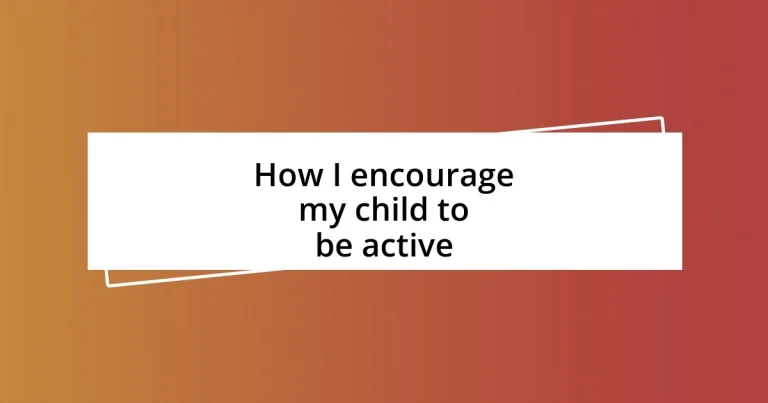Key takeaways:
- Activity fosters creativity, confidence, and perseverance in children and should be integrated into daily life as a joyful experience.
- Recognizing and aligning with children’s interests helps make physical activity feel enjoyable and engaging, encouraging them to embrace fitness.
- Celebrating achievements, no matter how small, reinforces motivation and builds a strong foundation for a lifelong passion for movement.

Understanding the importance of activity
Understanding the importance of activity goes beyond just maintaining a healthy weight; it’s about nurturing a sense of joy and exploration in our children. I remember taking my son to the park for the first time. He dashed off so quickly, his laughter echoing as he climbed the jungle gym. In that moment, I realized that activity could foster creativity and imagination, building a world where children learn to interact not only with their environment but also with their own bodies.
When I think about the long-term benefits of staying active, it’s not just physical health I consider. Regular activity cultivates discipline, builds confidence, and teaches my child how to cope with challenges. Sometimes, I ask myself: how else can I instill a sense of perseverance in him? I find that outdoor play, whether it’s a simple game of catch or an adventurous hike, can be fundamental in shaping my child’s mentality toward obstacles.
I’ve noticed that children inherently crave movement, often turning mundane moments into exciting escapades. For example, my daughter transforms chores into races, creating a sense of purpose and fun while staying active. Isn’t it fascinating how easy it can be to incorporate movement into everyday life? By understanding the importance of activity, I aim to make fitness an integral part of our family culture, one joyful step at a time.

Recognizing your child’s interests
Recognizing your child’s interests is pivotal in encouraging them to be active. I still remember when my youngest daughter discovered her passion for dancing. It wasn’t just about rigorous classes; it was her way of expressing joy. When I saw her twirling around the living room, with laughter spilling over, I realized that activity doesn’t have to be a chore. It should resonate with their interests, and if they love it, they’ll gravitate towards it naturally.
To better recognize your child’s interests, consider these points:
- Observe what activities excite them—do they light up at the mention of team sports or prefer solo activities like swimming?
- Engage them in conversations about their favorite pastimes—sometimes, what they love isn’t obvious unless you ask.
- Join them in various activities to see what they genuinely enjoy. I often try different sports together, and it’s always enlightening.
- Pay attention to how they play. My son, for instance, turned every stick into a sword or hiking stick, revealing his adventurous spirit.
By tuning into their unique preferences, I’ve found ways to make activity feel like their own adventure, allowing them to embrace fitness enthusiastically and authentically.

Setting a positive example
Setting a positive example is crucial when it comes to encouraging children to be active. I remember a Saturday morning when I decided to go for a run in the local park. My daughter, seeing my enthusiasm, hopped on her bike and followed me. It struck me how my actions inspired her to get moving. I realized that when I make physical activity a regular part of my routine, it not only benefits my health but also sends a powerful message that being active is important and fun.
In my experience, children are great observers. When my son sees me gardening or taking dance breaks while cooking, he often joins in, turning chores into playful activities. I feel this shared experience reinforces the idea that staying active is enjoyable. By incorporating movement into our daily life, I aim to show him that fitness doesn’t have to be rigid; it can be woven into the fabric of our everyday moments.
I’ve found that expressing joy during our active moments can set a lasting impression. For instance, after a weekend hike, I sensed a sparkle in my son’s eyes as he excitedly recounted each moment of our adventure. It made me think—how we react to physical activity truly shapes their perception of it. If I embrace movement with positivity, my children will likely carry that attitude into their own lives, seeing it as a rewarding and fun experience.
| Positive Examples | Impact on Children |
|---|---|
| Regularly participate in activities | Inspires children to join you |
| Incorporate movement in daily routines | Teaches that fitness is enjoyable |
| Express joy during active moments | Shapes their perception of physical activity |

Creating a daily routine
Creating a daily routine focused on activity has been a game changer in my household. I remember one afternoon when we decided to designate a specific time for outdoor play right after school. It became a delightful transition for my children, shifting their energy from classroom to open air. This not only provided a sense of structure but also gave them something to look forward to each day.
One strategy I’ve found particularly effective is making physical activity a family affair on weekends. From bike rides to family soccer matches, it’s a great way to bond while staying active. Just last weekend, we organized an impromptu “silly sport day,” where we invented our own games. Seeing my kids laughing and running around without a care in the world reminded me that fun is the best motivator. It raises the question—how often do we let laughter lead our activities?
Additionally, I always encourage my children to set their own activity goals within our routine. For example, my daughter aimed to hit a certain number of hula hoop spins each week. When she reached her goal, the pride in her smile was priceless. It made me realize that allowing them to take ownership of their routines fosters a genuine love for being active. What if we reframed our daily routines not as restrictions but as opportunities for creativity and exploration?

Encouraging outdoor play
Encouraging outdoor play is more than just a suggestion; it’s about creating an inviting environment for kids. I remember a warm evening when I set up a small obstacle course in our backyard using items we already had at home. My kids were hesitant at first, but when they saw me trying to navigate it, their curiosity piqued. It turned into an impromptu competition, where laughter echoed throughout the yard. This experience reminded me that making outdoor play accessible and fun can spark their interest significantly.
I’ve found that planning spontaneous outdoor activities works wonders too. One afternoon, I said, “Let’s go on a nature scavenger hunt!” We grabbed some old bags and started seeking out unique leaves, stones, and flowers. Witnessing their excitement as they discovered new treasures reignited that childlike wonder in me, and it made me realize—what simple activities can unravel a world of adventure? Engaging in outdoor play doesn’t need to be planned; sometimes, the unstructured moments become the most memorable.
Lastly, I can’t stress enough how important it is to provide them with the right tools to ignite their imagination. I decided to invest in a kite on a whim, recalling the joy it brought me as a child. On the day we finally flew it, I watched as my son started running to catch the breeze, the kite dancing above him. Seeing his sheer excitement made me think: how many opportunities do we miss by sticking to screens? Encouraging outdoor play not only cultivates physical activity but nurtures their creativity—it’s about setting them free to explore their surroundings.

Choosing active family activities
Choosing active family activities can be a joyful exploration for everyone involved. Just the other day, I proposed a family hike at a local nature trail. The initial eye-rolls quickly turned into excitement as I promised a picnic at the end. Watching my kids navigate the trail, with wide eyes discovering butterflies and squirrels, reminded me how easy it is to uncover nature’s wonders when we step outside our comfort zone together.
It’s also essential to consider everyone’s interests when planning these activities. I’ve learned that mixing things up helps keep the enthusiasm alive. One Saturday, we decided to hit the local skate park instead of our usual cycling route. My daughter, who had been a bit shy about skating, surprised us all by trying it out after watching her brother. The joy that came from her newfound confidence was contagious, making me think: how often do we underestimate what our kids are ready to try?
Sometimes, the simplest activities turn into the most cherished memories. Last month, we gathered our old board games and turned the living room into a game night, adding a twist: every time you won a round, you had to perform a fun exercise challenge, like jumping jacks or a funny dance. The laughter that filled our home was electrifying. It occurred to me that being active doesn’t always mean running or jumping; it can also be about sparking joy and connection. How can we create a family culture that celebrates movement in every form?

Celebrating achievements and progress
Celebrating achievements and progress is crucial for fostering a sense of accomplishment in my children. I remember when my son successfully completed his first 10-minute jog without stopping. I made a big deal out of it, complete with a “runner’s award” made from construction paper. His eyes lit up with pride, and in that moment, I realized how impactful it can be to acknowledge even the smallest milestones. What better way to nurture their motivation than to create a tangible reminder of their progress?
I’ve also found that documenting their journey serves as a great motivator. One summer, we started a “fitness journal” to track our family activities. Each week, my daughter would decorate the pages with stickers and drawings representing our adventures. This not only allowed them to see how far they’ve come but also turned into a cherished keepsake filled with memories. Reflecting on those moments prompted me to ask: how can the act of sharing one’s progress inspire future efforts and self-confidence?
Looking back, I see that celebrating achievements goes beyond just recognizing successes; it’s also about acknowledging efforts. My youngest took up swimming initially fearing the water. When he managed to float for the first time, I cheered as if he’d conquered a championship. Those cheers, alongside hugs of encouragement, shaped his belief in himself. I’ve learned that every bit of encouragement builds a stronger foundation for their active lifestyle. What if moments of recognition become the seeds for a lifelong passion for movement?














